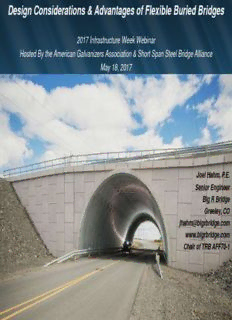
Design Considerations & Advantages of Flexible Buried Bridges PDF
Preview Design Considerations & Advantages of Flexible Buried Bridges
Design Considerations & Advantages of Flexible Buried Bridges 2017 Infrastructure Week Webinar Hosted By the American Galvanizers Association & Short Span Steel Bridge Alliance May 18, 2017 Joel Hahm, P.E. Senior Engineer Big R Bridge Greeley, CO [email protected] www.bigrbridge.com Chair of TRB AFF70-1 bigrbridge.com Presentation Outline •Introduction to Buried Bridges •Introduction to Design •Case studies / applications / innovations •Questions Deep Corrugated Buried Bridges •Definition of Buried Bridges: •Bridge defined by AASHTO as a single span or combination of smaller spans totaling at least 20 ft. •Buried Bridge is any bridge that derives its support from both the structure and the surrounding soil through soil-structure interaction. •Structures consisting of corrugated metal are Flexible Buried Bridges. •AASHTO LRFD Bridge Design Specifications Section 12.8.9 (design). •AASHTO LRFD Bridge Construction Specifications Section 26 (construction). •AASHTO Materials Specifications – M167 •AREMA Chapter 1, Section 4 •NOT the same thing as culverts, although perform some similar functions. Material & Design Properties •Material properties provided in AASHTO M167 / ASTM A761 •Design properties provided in AASHTO LRFD Section 12 (Appendix A12) •Construction specifications in AASHTO LRFD Section 26 •Thicknesses up to 0.380” thick. •Hot dipped galvanized with 3.0 oz/ft2 coating weight (50% more than CSP) •¾” or ⅞” diameter high strength steel bolts (ASTM A449) •Granular backfill with same electrochemical requirements as those in AASHTO LRFD Design Section 11.10.6.4.2 for MSE walls. Considers pH, resistivity, chlorides, sulfates, organics. Some design flexibility with mechanical properties. Property Aluminum (ALSP) Shallow Corrugated Deep Corrugated Steel Steel Geometry Types Small arch, box, closed Arches, closed shapes Arch, box, pipe, multi-radius shapes arches Corrugation Profile 9” x 2.5” 6” x 2” 15” x 5.5” Design Yield Strength 24 ksi 33 ksi 44 ksi Relative Stiffness ~1.5 x shallow 1 (baseline) ~9 x shallow ~6.25 x ALSP Steel Corrugation Profiles •Advantages of Flexible Buried Bridges vs. Traditional Bridges: •LVR Buried Bridge Applications: Introduction •Advantages of Flexible Buried Bridges vs. Rigid Bridges: •Lower foundation costs & no bump at the end of the bridge (if foundations properly designed) •ABC benefits - No heavy equipment or specialized labor skills needed for construction, Shorter design & material lead times, can be easily staged, no need to coordinate cranes & delivery, & cheaper/easier to transport. •Able to accommodate complex site geometries & road profiles, No need to minimize bridge width (allowing for pedestrian access, bike lanes, etc.), Can be lengthened for future road widening •Structural redundancy, resilient, aesthetic flexibility, sustainability, enhanced safety benefits, reusing bridge foundations Introduction •Buried Bridge Applications: •Bridge replacement •Limited site access / remote locations •Grade separation •Staged construction •Drainage structures •Rehabilitation of existing bridges •Wildlife / aquatic crossings •Environmentally sensitive crossings •Canal / utility crossings •Pedestrian access •Emergency / temp / detours •Single span alternative for multi-cell hydraulic crossings •Heavy vehicular loads •Any bridge project! AASHTO LRFD Design Checks •Shallow Corrugated Arches – Design Based on Thrust Loads (Section 12.7) •Wall Area (12.7.2.3) •Buckling (12.7.2.4) •Seam Strength (12.7.2.5) •Flexibility for Installation (12.7.2.6) •Shallow Corrugated Boxes – Design Based on Flexure (Section 12.9) •Moment Capacity (12.9.4.2, 12.9.4.3) •Typically Includes Circumferential Reinforcing (Ribs) AASHTO LRFD Design Checks •Traditional Long Span Structures – Design Based on Thrust (Section 12.8) •Shallow corrugated structures with a radius > 13 ft •Wall Area, Buckling, Seam Strength, Flexibility per Section 12.7 •Additional Requirements Based on Geometric Limits (Table 12.8.3.1.1-1) •Requires Special Features (typically longitudinal stiffeners, concrete relief slab, or ribs) AASHTO LRFD Design Checks •Deep Corrugated Structures (corrugation profile depth > 5 in) – Design Based on Thrust and Flexure (Section 12.8.9) •Requires Rigorous Analysis (typically FEA) •Wall Area, Seam Strength Same as for Long Span Structures •Check Flexure (includes reduction for connections) •Global Buckling Check (Eq. 12.8.9.6-1) •Moment-Thrust Interaction Check (Eq. 12.8.9.5-1) •Flexibility, Special Features, Shape Requirements for Long Span do not Apply (12.8.9.1) •Includes Requirements for minimum cover and backfill zone width (12.8.9.2 & 12.8.9.4)
Description: